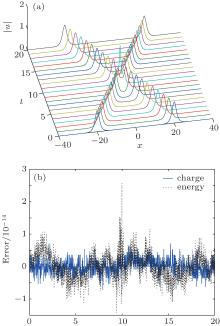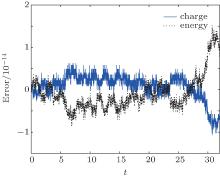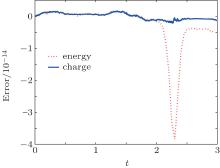†Corresponding author. E-mail: thomasjeer@sohu.com
*Project supported by the National Natural Science Foundation of China (Grant Nos. 11201169 and 11271195) and the Qing Lan Project of Jiangsu Province, China.
We propose a new scheme for simulation of a high-order nonlinear Schrödinger equation with a trapped term by using the mid-point rule and Fourier pseudospectral method to approximate time and space derivatives, respectively. The method is proved to be both charge- and energy-conserved. Various numerical experiments for the equation in different cases are conducted. From the numerical evidence, we see the present method provides an accurate solution and conserves the discrete charge and energy invariants to machine accuracy which are consistent with the theoretical analysis.
The high-order nonlinear Schrö dinger equation with a trapped term (HNLSET)[1] is

where 


and energy conservation law

There have been some works for the HNLSET in special cases. For m = 1, g(x) = 0, and ħ (| u| 2) = | u| 4, the equation will be nonlinear Schrö dinger (NLS) equation, which has been solved by various methods.[1– 5] For m = 1 and ħ (| u| 2) = | u| 4, the equation is called trapped NLS equation. Pé rez-Garcí a and Liu[6] proposed several numerical methods for the equation with g(x) = − x2/2 and Wang[7] suggested the split-step finite difference method. In Ref. [8], Dehghan and Taleei proposed a time– space method for the numerical solution of the trapped NLS equation. In Ref. [9], Hong and Kong discussed some multi-symplectic algorithms for the HNLSET with ħ (| u| 2) = 3| u| 4 and g(x) = − 150sin2x.
For the HNLSET (1), some authors also have done some works. Chao[10] proposed a charge and energy-preserving finite difference scheme. In Ref. [11], Zeng derived an explicit and conditionally stable leap– frog difference scheme. In Ref. [12], Kong et al. proposed a symplectic scheme for the problem. Although there have been some methods for the HNLSET (1), most of them are not energy-preserving. Spectral and pseudospectral methods have been very popular in recent decades because of their convergence accuracy in solving smooth problem, especially with the advent of the fast Fourier transform. Thus, the problem now is whether we can design a stable and efficient Fourier pseudospectral method for the HNLSET (1) as well as preserving the two conserved quantities (2) and (3).
The arrangement of this paper is as follows. In Section 2, we construct a Fourier pseudospectral method for the HNLSET (1). Then, we analyze the charge and energy conservative properties. Some numerical experiments are presented in Section 3. We finish the paper with a summary in the last section.
In order to derive the method conveniently, we introduce some notations: xj = a + jh, tn = nτ , j = 0, 1, 2, … , J; n = 0, 1, 2, … , where J is an even integer, h = (b − a)/J and τ are spatial length and temporal step span. Let 






As we know, the best merit of the spectral and pseudospectral methods is their rapid convergence accuracy in solving smooth problems. We approximate u(x, t) by 


where μ = 2π /(b − a). The first-order differential operator ∂ x yields the Fourier spectral differentiation matrix D1 ∈ ℝ J× J with entries

j, k = 0, 1, … , J − 1. It is worth noting that D1 is skew-symmetric. Generally, the Fourier spectral differentiation matrix for ∂ xx is D2 (see Ref. [13]). In Refs. [9], [13]– [18], the authors used 





where p is a positive integer, 



Applying the midpoint rule with respect to time and the Fourier pseudospectral method with respect to space in HNLSET (1), we have a scheme

where gj denotes the value of g(xj). In order to analyze its conservative properties conveniently, we rewrite the scheme (4) into a vector form

where g = (g0, g1, … , gJ − 1)T and ‘ · ’ represents point multiplication between vectors, i.e., u· v = (u0v0, u1v1, … , uJ − 1vJ − 1)T. Next, we will present some conservative properties of the method (5).
Remark 1 As usual, 





Theorem 1 With the initial and periodic boundary conditions, the method (5) preserves the charge conservation law exactly, that is

Proof Taking the inner product of Eq. (5) with un + 1 + un yields

The first term becomes

where 

is real. The last term is also real. Thus, the imaginary part of Eq. (7) implies the discrete charge conservation law (6). ◻
Remark 2 The discrete charge conservation law is unitary. Thus, the scheme (5) is unconditionally stable with respect to the initial values.
Theorem 2 For the periodic boundary conditions, the scheme (5) satisfies the implicit discrete energy conservation law

Proof Computing the inner product of scheme (5) with un + 1 − un yields

The first term 

One derives immediately from the third term that

The last term

Therefore, taking the real part of Eq. (9), we complete the proof. ◻
Remark 3 Theorem 2 implies that the scheme (5) does not explicitly conserve the energy conservation law over time in the general case. The reason is that the terms

cannot be vanished. However, for some special case of ħ (| u| 2), we will have an explicit energy conservation law.
Corollary 1 If ħ (| u| 2) = ρ , where ρ is a given constant, then we have explicit discrete energy conservation law 
Corollary 2 For the case of ħ (| u| 2) = ρ | u| 2, where ρ is a given constant, the following explicit discrete energy conservation law is held 
Corollary 3 If ħ (| u| 2) = ρ | u| 4, where ρ is a given constant, the scheme (5) possesses explicit discrete energy conservation law

where

In this section, we will test the numerical accuracy and preservation of the proposed method (5) for the HNLSET (1). In the following computations, the accuracies of the numerical solutions are calculated by

and 


Consider the linear test problem 


| Table 1. The errors in solution, charge and energy at T = 2. |
In order to get insight into the performance of the method for the nonlinear problem, we consider the NLS equation iut + uxx + 2| u| 2u = 0.
Example 1 (soliton solution) NLS equation admits the exact soliton solution

We take u0(x) = u(x, 0, 2, 0), − 10 ≤ x ≤ 10 as the initial condition. The computational parameters are τ = 0.01 and J = 200. The numerical results are listed in Table 2. One can see the errors in solutions are satisfactory and the errors in charge and energy invariants are within the roundoff error of the machine.
| Table 2. The errors in solution, charge, and energy for NLS equation. |
Example 2 (solitons collision) We consider initial condition u0(x) = u(x, 0, 2, − 20) + u(x, 0, − 2, 20) over the region − 40 ≤ x ≤ 40. The simulations are done with τ = 0.01 and J = 200 up to T = 20. The interaction of the two solitons is illustrated with Fig. 1(a). The two solitons move in opposite directions and merge into a large wave at T = 10. After the interaction, both of them bound back along their original paths with original shapes and velocities. Figure 1(b) shows the errors in charge and energy. It is clear that the two invariants are conserved exactly.
We consider equation iut + uxx − cos2xu − | u| 2u = 0 with initial condition u0(x) = sinx, x ∈ [0, 2π ]. Wang[7] studied this problem by using the split-step finite difference (SSFD) method. The equation has the exact solution u(x, t) = sinx exp(− i3t/2). We compute the problem with τ = 0.01, J = 128 up to T = 32. The maximum errors at various times are shown in Table 3. We see that the present method provides a more accurate solution than SSFD. The residuals of charge and energy are displayed in Fig. 2.
| Table 3. The maximum errors in solution at various times. |
We study the the following fourth-order NLS equation with a sine-trapped term and 2π -periodic initial value problem iut + uxxxx − 150(sinx)2u + 6 | u| 2u = 0, 
| Table 4. The errors in solution T = 1. |
For the HNLSET (1) with periodic boundary conditions, we apply the Fourier pseudospectral method with respect to space and the midpoint rule with respect to time, and then derive a new scheme. We prove the method conserves the charge and energy conservation laws exactly. Various numerical experiments are implemented to exhibit the performance of the method. Numerical results verify the proposed scheme is charge- and energy-conserved, and also reveal it is more efficient than many existing methods.
The present method can also be applied to two- or three-dimensional problems. To illustrate this, we consider two-dimensional NLS equation

on spatial domain [xL, xR] × [yL, yR] with periodic boundary conditions. For simplicity, let hx = (xR − xL)/J and hy = (yR − yL)/J. Since the matrix 

where the entries of the matrix Un satisfy [Un]j, k = u(xj, yk, tn). Because of 



where 

The system of the nonlinear equations can be solved by a simple iterative method, i.e.,

where q means the iterative step. Further, using the relation 
| 1 |
|
| 2 |
|
| 3 |
|
| 4 |
|
| 5 |
|
| 6 |
|
| 7 |
|
| 8 |
|
| 9 |
|
| 10 |
|
| 11 |
|
| 12 |
|
| 13 |
|
| 14 |
|
| 15 |
|
| 16 |
|
| 17 |
|
| 18 |
|









